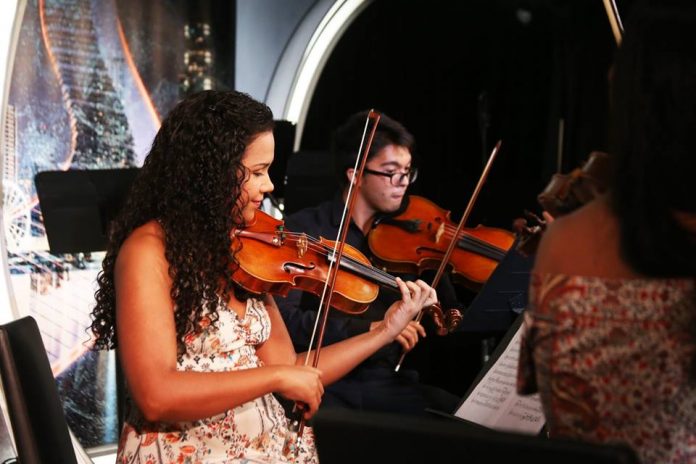Maastricht – With the successful performance of the Aruba Symphony Festival (ASF) this summer, one impressive captured moment was when a group of children who were participating in a local summer camp were invited to witness what a musical symphonic orchestra looks and sounds like in Cas di Cultura.
The representatives of the ASF expressed that their intention was to inspire the children present to consider learning how to play an instrument. Besides just witnessing a beautiful performance by the participants of the ASF, some children got the opportunity to engage in the musical activity and experienced hands on how to “direct” the orchestra. With this lead, today we are going to discuss the role of creativity in the development of children, considering the importance of exposing children to the opportunity to developing their artistic and creative skills.
It is known to many that creativity starts early in life. Babies and toddlers express themselves through language, singing, dancing, the way they play with their toys, painting etc. If we try defining creativity we can summarize the following: the ability to see things in new ways, boundary breaking and going beyond the information given (thinking outside the box), thinking unconventionally, making something unique, or combining unrelated things into something new. From previous research, specific personality traits have been identified linking to people who are highly creative. These personality traits include: being open to the new or unexpected; a tolerance for ambiguity; a willingness to experiment and take risks impulsivity for complexity; being highly intuitive and sensitive; being flexible; individualism, independence and introversion; nonconformity; playfulness and a sense of humor; and a strong sensory awareness (Gelineau, 2004).
Creativity is just connecting things. When you ask creative people how they did something, they feel a little guilty because they didn’t really do it, they just saw something – Steve Jobs
Now, if creativity is known for being inherent in people, there must be external developmental factors that could either enhance or deplete creative potential as growth occurs. Potential obstacles for creativity to manifest in the development of children can occur from their home environment; school environment; gender roles; and the society, culture and traditions they pertain to. We all know the saying “education starts at home” and the fact that the home environment is the first space where children develop their characteristics and abilities. In the case of highly creative children most times behave and act differently due to their particular personality traits. Families in this case need to be informed about the essence of creativity and they should be educated on how to enhance the development of their children and not break their spirits.
Now, considering the special personality traits of highly creative children, too often they are expected to perform well in a school system that for the most part is based on a convergent way of thinking, which goes against all traits of these artistic and creative children. These children might rebel or become extremely uninterested in the daily activities they are expected to perform. Next to this, besides the environment children are growing up in, most of the time they also face societal norms and expectations. In this case, gender roles have a lot of influence of creative children by pinpointing expectations on boys to be manly and girls to be sensitive. It is hard for creative boys who want to become fashion designers or ballet dancers, because they are considered more feminine traits, or even girls who want to become sculptors or work with wood and other raw materials, because they are considered more manly. On the other hand, another way we can limit highly creative children is by imposing cultural traditions that go against their core personality. It is important to recognize a child’s abilities and respect their individual development, because in the end they will be successful because they got the chance to grow and strengthen what they naturally are talented at.
It is the supreme art of the teacher to awaken joy in creative expression and knowledge – Albert Einstein
Now how can we facilitate creativity in children (not only highly creative ones)? Well, there are endless ways to accomplish this. One way is to simply celebrate creativity and diversity by allow children to be curious. It is important for children to realize that creativity is not only limited to arts, but it can transcend into other subjects as well. Also, we must value a child’s creativity and not diminish their vision and freedom to explore “newness”, but instead encourage children to be different. This will require the provision of time and space for creative expression, and materials conductive to creativity. Allow children to activate the right side of the brain which is completely depended on context formation, visual stimuli, intuition, emotion and imagination. Fun fact, guess which side of the brain is most dominant. Well, it is the right side, the unconventional side, the side most people ignore.
Coming back to the influence of music on children, which is simply one artistic element available, it is important to also understand how music can add value to the child on a deeper level. Music does not only teach children how to play an instrument, it teaches the child team work skills, responsibility, accountability, punctuality, respect, ownership, humbleness, perseverance, focus and concentration abilities, the ability to listen, good coordination and structure. But notice, these skills are also important when children grow up to be teenagers and soon after, young adults that should be productive citizens in society. Music teaches children expression through stability, which is a gift all children should experience at least once in their lives.
Without change, there is no innovation, creativity, or incentive for improvement. Those who initiate change will have a better opportunity to manage the change that is inevitable – William Pollard
Now, as a society we keep hearing concepts such as sustainability, innovation, creativity, knowledge and change, but these concepts are rooted in the foundations we have laid from when we were little. If we want to become an innovative island, we should encourage innovative behavior in our children. If we want positive socio-economic development, we should realize that many traits of these highly creative children are traits needed to become a successful entrepreneur. If we want sustainability, we should consider not “throwing away” perfect capable and talented children into the sea of convergence. In the past we discussed impressive musical programs such as the “Leer Orkest” in the Netherlands, which provides a haven for all children respectable of their background and resources. So, we should create the space for children to make mistakes and learn from them by allowing them to initiate that improvement. Change will be inevitable as time goes by, but one thing we know for sure: creativity and innovation go hand in hand. The vision for enhancing the creative development in children goes beyond just entertainment, it determines the holistic development of the next generation. q












